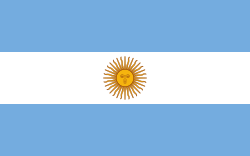 Flag of Argentina | |
 Haei Sau Buddhist Temple in Buenos Aires | |
| Total population | |
|---|---|
| c. 35000 – c. 40000 [1] (0.5%) | |
| Regions with significant populations | |
| Throughout Argentina | |
| Religions | |
| Tibetan Buddhism, Mahayana, Theravada | |
| Scriptures | |
| Pali canon | |
| Languages | |
| Spanish and others |
Buddhism is a minority religion in Argentina, where, in addition to the majority of the Christian population, the rate of self-professed Buddhists is about 0.5%. [2]
Contents
Buddhism in Argentina has been practiced since the early 1980s. Chinese Buddhist immigrants had established their first Buddhist temple in 1986, and Korean Buddhist immigrants also founded their own temple. Since then, many groups have been giving teachings, some of them rooted in the Sōtō tradition from Japan, but also in many Tibetan institutes for the practice of meditation (Mahamudra, Dzog Chen, Lam Rim).
Nowadays, many Buddhist centres have flourished and propagated widely. Buenos Aires is home to about 5,000 immigrant Buddhists and 25,000 Buddhist converts. [2]
Many organizations have cooperated to bring relics of the Buddha to Argentina. This event was supported by the Royal Embassy of Thailand in Buenos Aires.
Among scholars who contributed to the spreading of Buddhism in Argentina are Samuel Wolpin, whose books have opened a door to many students and the general public, and Carmen Dragonetti and Fernando Tola, who have been researching and studying Buddhism for many years, with their books translated to many languages.
Teachers who have visited the country include Pu Hsien, founder of the Tzong Kuan Temple, Mok Sunim, responsible for spreading of Korean Buddhism in the early twenty-first century, Chogyal Namkhai Norbu, founder of the international Dzog Chen Community who transmitted Dzog Chen teachings here, and Lama Ngawang Sherab Dorje, who visited Argentina many times. Local teachers include Augusto Alcalde (Diamond Sangha) the first Roshi in this country. Jorge Bustamante, Soto lineage. Alberto Pulisi (Upasaka). Gonzalo Barreiros (Dharma Teacher), and two Argentine lamas, Horacio and Consuelo. [3]